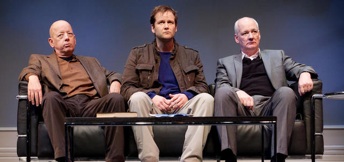Workbook: Art
HERE ARE SOME SKETCHES AND IDEAS IMAGES FOR OUR CANADIAN STAGE PRODUCTION OF ART
Left, Evan Buliung, right, Colin Mochrie; this is the first time we will have a chance to work with these talented actors. Evan plays Yvan, and Colin will play Serge - the part Morris played a decade ago in Vancouver. Below, Peter Donaldson, who will play Marc. Peter has worked with us before, most notably in the original Toronto production of 7 Stories in 1990
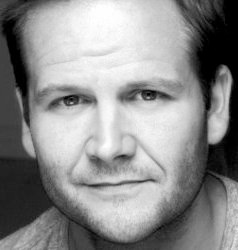
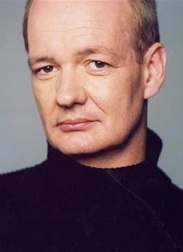
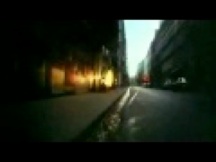
Yasmina Reza (b. 1959) studied at Paris X University and later at the Jacques Lecoq Drama School. She began working as an actress in France and appeared in numerous plays by contemporary authors as well as plays by Moliere, Marivaux, and Sacha Guitry. In 1987 she wrote Conversations after a Burial for performance in France and won the prestigious Moliere Award for best author as well as many other awards. Following its performance in France, the play was produced in translation in Europe and South America.
Rezas French translation of Steven Berkoffs adaptation of Franz Kafkas novel The Metamorphosis for performance by Roman Polanski was nominated for the 1988 Moliere Award for translation. Winter Crossing (1990), her second play, won the 1990 Moliere Award for best fringe production that year. Art premiered in Berlin and opened in Paris in 1994, where it won the Moliere Award for best author, best play, and best production. It also won prizes in London for best comedy and in Germany for best foreign play. The Unexpected Man (1995) was produced in London, France, and several other European countries. It was revived in 1998 by the Royal Shakespeare Company at the Barbican in London and has also played in New York.
In addition to playwriting, Yasmina Reza has also been engaged in screenwriting, with two recent films shown in Europe: See You Tomorrow and Lulu Kreutzs Picnic. Her novel, Hammerklavier, was published in 1997.
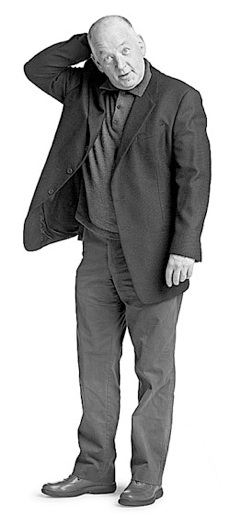
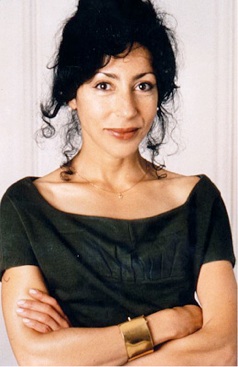

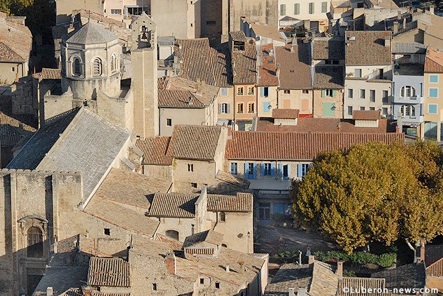
Malevich described his aesthetic theory, known as Suprematism, as "the supremacy of pure feeling or perception in the pictorial arts." He viewed the Russian Revolution as having paved the way for a new society in which materialism would eventually lead to spiritual freedom. This austere painting counts among the most radical paintings of its day, yet it is not impersonal; the trace of the artist's hand is visible in the texture of the paint and the subtle variations of white. The imprecise outlines of the asymmetrical square generate a feeling of infinite space rather than definite borders.
Carcassone, above, a beautiful medieval walled city, Cavaillon, below, a shithole off the A7 en route to Avignon. Interesting, perhaps sadly, we have never been to Carcassone, but Cavaillon we have circumvented at least six times.
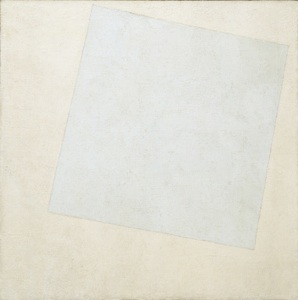

Christopher Hampton - translator
BIOGRAPHY
Christopher Hampton is a playwright, screenwriter, director and producer. Born in 1946 in Portugal, he spent his childhood in Aden, Egypt and Zanzibar, then studied French and German at Oxford University. He was the youngest writer ever to have a play staged in the West End, and in the late 1960s, was resident dramatist at the Royal Court Theatre.
His own stage plays include When Did You Last See My Mother (1966), performed at The Royal Court Theatre, Total Eclipse (1968) about the relationship between Rimbaud and Verlaine; the comedy The Philanthropist (1970); Savages (1974) and Treats (1976).
His screenwriting credits include translations of classics such as Ibsens A Dolls House (1970); Tales from the Vienna Woods (1977) and Molieres Tartuffe (1984), and his television work includes The History Man for the BBC, The Ginger Tree (1989) and Tales from Hollywood (1989).
In 1985 he wrote the play Les Liaisons Dangereuses, adapted and translated from the novel by Choderlos de Laclos, and later adapted this as a screenplay. The resulting film, Dangerous Liaisons, was an international success and won many awards. He also wrote and directed Carrington, about the relationship of Lytton Strachey with the painter, Dora Carrington.
Other work includes translations of Yasmina Rezas work for the stage, and further versions of Chekhov and Odon von Horvath. He wrote the stage adaptation and co-wrote the lyrics for Andrew Lloyd Webbers Sunset Boulevard, and the recent screenplay for the BAFTA nominated film, Atonement.
Most famous phallus in France, the Eiffel Tower.



Here are three iphone photographs of the set model. This maquette is in quarter inch scale, which is large enough for the theatre to price and for Ken and Morris to work out their preliminary ideas; soon they will meet up with lighting designer Andrea Lundy to begin discussing how to differentiate the three different locales, since the furniture will not change and different locations will depend on lighting changes. They can also experiment with model with video projections, which they are planning on using in the production.
art: noun, the conscious use of skill and imagination, esp in production of aesthetic objects.

The Bluma Appel Theatre at the St Lawrence Centre has been recently renovated, in other words, they changed the colour of the seats. It is still a behemoth of a theatre space, nearly nine hundred seats and a stage so wide by the time somebody crosses from one side to the other you have often forgotten what play you are watching. It is notorious for killing theatre productions, including some of our own. Hysteria didnt work there, but the Overcoat did. The hit and miss nature of the venue is what makes it scary and exciting. In order for a play as intimate as Art to work in the Bluma, we need to focus on the size of the ideas in the piece and play up the notion of small men in big surroundings. The fact that the actors will be dwarfed by the space we hope will give the audience an added sense of the absurdity which runs through the play; in other words, their passion is both meaningful and meaningless.
Art premiered in English at the venerable Wyndhams Theatre in Londons West End, which is where we saw it. Any guesses what other play ran for four months at Wyndhams? If you said Vigil youd be wrong because it was retitled Auntie and Me, it premiered at this beautiful jewel of a theatre in January of 2003, shortly after Art played there.
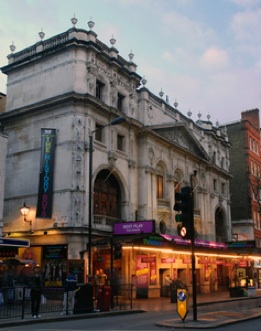
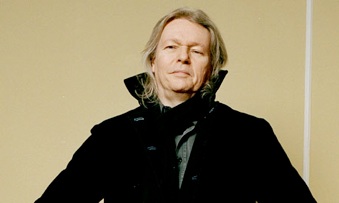
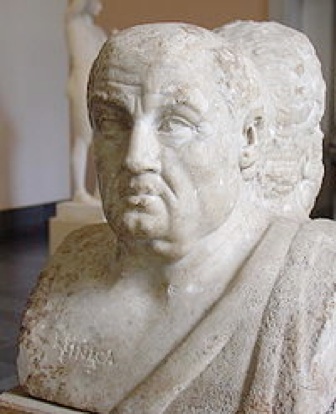
Lucius Seneca, philosopher, dramatist. Although Morris studied four years of Latin, he never read Seneca, since that would have required a fifth year.








Below, psuedo Flemish view of Carcasson, mentioned by Serge, which hangs in Marcs apartment. The mens paintings describe the two completely different men who own them, the chief source of their falling out, and the subject of the play. When Serge buys a white painting on a white canvas, it reveals, in Marcs view, not only a fundamental flaw in Serge but also in the very nature of relationships, namely that you can help form people, and take a part in their development, but you cant own them
Micheal Legouffe in the wardrobe department fits the actors for their costumes. Although the play was written in the 90s it can take place now. The men need to look contemporary without feeling too costumed, although we went with some French flare for Ivan
We borrowed some footage from an art film called cetait un rendezvous and mixed it with some footage of our own, to use at the beginning of the play and throughout.



Left, Evan shooting bit for opening sequence, with Cameron Davis on camera. Cameron is our video technician. The little guy in the background is Morris, and far right, Jack, assistant director. Right, rehearsal comes to a grinding halt while Colin and Evan discuss some deep inner meaning in the text with Morris, or they could just be trying to figure out where to go for lunch which at Berkeley Street can be an issue. Below, left, the prototype for the art work that hangs in Ivans apartment, referring to affectionately as a motel painting.
Ken takes a trip to the Hamilton workshop to check on the progress of the set building. The wall panel is fitted so the different paintings can quickly and easily slide into place. Centre, Chris Carlton, technical director for Canadian Stage, drapes himself over the giant pillar which will grace stage right, on another of the designers gigantic architectural show pieces. Nothing justifies Kens enormous appetite for artistic statement than a play called ART. Below, actual art from AGO, no, it is not white.





Rehearsal photos taken by Jack Grinhaus, assistant director, during afternoon session in the hall. Rehearsal, of course, being the sacred and honorable process of learning lines. For a director and stage manager, top centre, watching lines being learned can be a scintillating process. For actor Buliung, top left, a big headache, for Mochrie, top right, an opportunity for an amusing anecdote, and for Donaldson and Mochrie, left, a staring contest. The rehearsal hall at Berkeley Street sits opposite the alley from the Canadian Opera Company where trucks load and unload all day, lending an atmosphere solemnity to the proceedings, and preparing the actors for the background noise of cellphones and candy wrappers during the actual performance.
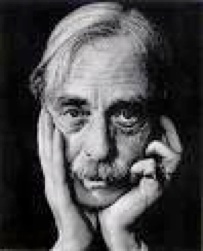
Paul Valery, about whom a rather nasty argument ensues, one of many pointless and destructive but very funny disagreements in the play. Passionate arguments about nothing are not only a favorite pastime of the French. Ken and Morris have been arguing for nearly thirty years about toast crumbs.
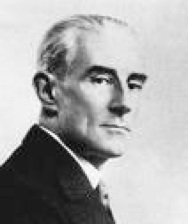
Maurice Ravel, left, superb French composer, most famous for Bolero, once spent time at Debussys house where they played each others works, which sounds almost sexy. We have used Ravels music before, most recently in Design for Living at Shaw. In Art we are using mostly his Violin Sonata, plus other bits of his piano works. There is a pathos in his work that really suits the style of the play because as angst ridden as it is, there is a distinct sense of humour in it.

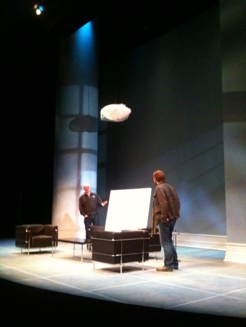
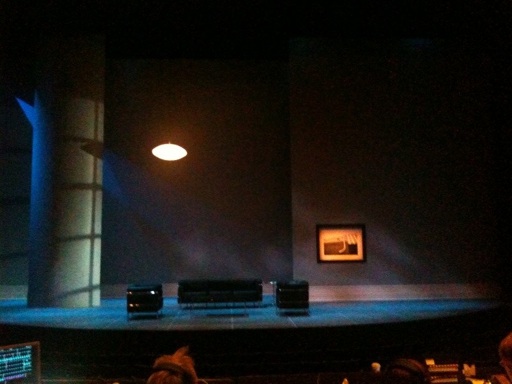
Working on light and sound cues in the theatre. Far left, a shot from the balcony where you get a really clear picture of the extreme height of the walls but also an entirely different perspective. Ken likes to go up into balconies and take pictures to show his partner how the set looks from up in the gods, since Morris never goes up there to look, a debate between them which has raged for as long they have been working together. Which is better, to create the work for optimum viewing, or to be seen at different angles? Would a visual artist care if his work was viewed from as far away as possible? For every artist there is a different point of view, but naturally Ken would like the wide view since it is more about the set design, and Morris would like a more concentrated view, because of all the other elements, not the least of which is the acting. Here, the actors must stand in their positions, sometimes interminably, while the lighting designer adjusts lights, the sound designer adjusts sound levels and the stage manager enters cues into her book. Up left, a closer look at the set, from an extreme side angle, another position Morris does not care for. Directors, in the end, should design theatres, not architects. At bottom, the set from directly on, sans actors, probably taking a much needed break. Once we are in the theatre, different unions become involved with the process, so the schedule changes, the focus changes, the whole atmosphere of a production changes from one of enclosed intimacy, to one of technical practicalities and deadlines. This opening up of the process is both exhilarating and frustrating for actors and directors alike, but for designers its what they have been waiting for.

Evening of dress rehearsal, backstage with Peter, already in costume, and Colin, not dressed yet. Evan, nowhere to be found. Dress rehearsal is for crew, staff, and invited guests, to try out the show on a small but appreciate first audience. Right, costume sketch for Peter as Marc.
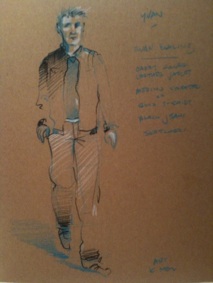
Above, Morris and Cameron behind the camera, as Peter films video bit for scene transition. Right, a costume sketch by Ken for Evan Buliung, and beside it, the end result. Costumes can and will go through many changes before opening, as this one did. Originally, the idea was a leather jacket, which we felt was a little too hip for the character of Yvan.

Left, costume sketch for Colin, originally a turtleneck which quickly had to change when Ken realized that it would not show up against all the black furniture. Also, turtlenecks were out of season, a consideration with shopped shows.


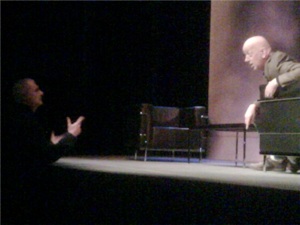

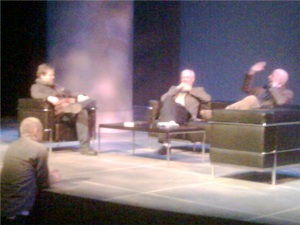
Technical rehearsals proceed, with Morris offstage, left, trying to convince Peter that he knows what he is talking about, right, the three actors try out the olives, which are actually prunes with kidney beans for stuck in them for pits, courtesy of props genius Mary Sporakis. Its because Colin and Evan have issues with olives, apparently. Lower left, Morris now tries to convince the entire cast, and lower right, the set without actors, which Ken has often stated is the ideal.
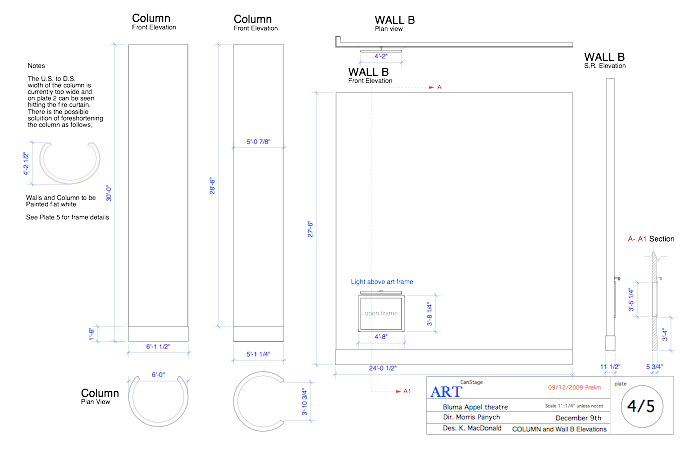
The set, deceptively simple, was nonetheless a tricky one. Not only did the pillar have to be specially built, the walls themselves, because of their size, required seamless joins, and even then, we had to keep the light off them in order to sell the idea of one complete unbroken surface. Our biggest surprise was how absorbing the colour grey was with the projections.
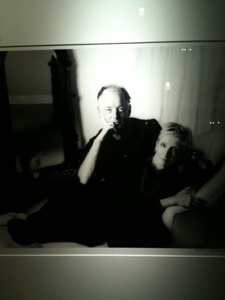
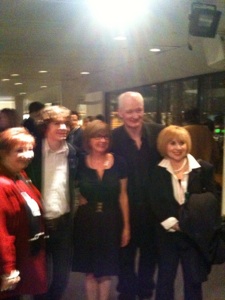
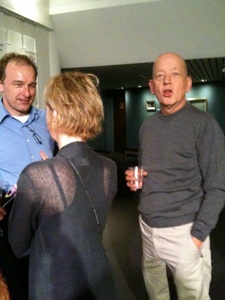
Opening night, the upstairs lobby of Canadian Stage where great, lively crowd celebrates with Peter, Colin, and Evan (nowhere to be found). It was a great night for everyone, cut short for Ken and Morris in order to go home and pack for San Francisco. Vigil begins tech the following day. Oddly, on their way home from the theatre, they spot this photograph in the window of a photo gallery, of Peter and his wife Sheila McCarthy, what a handsome couple.
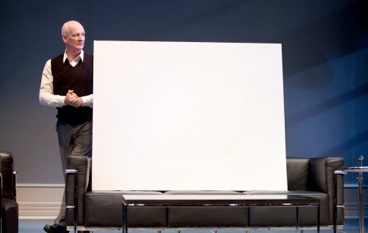
Production photos by Cylla Von Tiedermann, capture Colin Mochrie as Serge first introducing the subject and the three men reaching a catastrophic end, eating olives, below, left, Evan wraps up a breathless monologue about his wedding plans. Below, Donaldson gives Mochrie what for about art.

